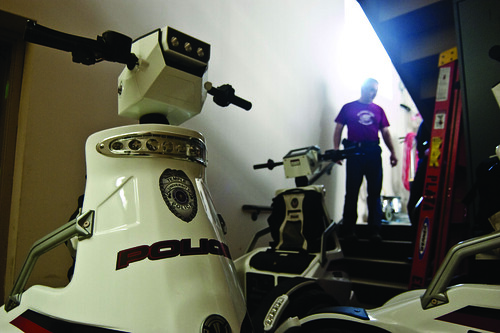Campus Safety Services recently purchased four T3s — electricity-powered, three-wheeled vehicles that resemble Segways — for $10,000 apiece to add to their fleet. Two of the vehicles will be used on Main Campus.

It may not be unusual for students to spot Temple police officers in patrol cars, vans or bikes, but they may have to look twice when they see officers riding around vehicles that resemble Segway-tricycle hybrids.
At the beginning of this semester, Campus Safety Services debuted four new T3s, which look like three-wheeled Segways that feature two large rear wheels and one smaller wheel in the front, Campus Safety Services Executive Director Carl Bittenbender said.
Like a Segway, a T3 can make a full 360-degree turn, and it operates on five speed settings – 5 mph, 8 mph, 10 mph, 12 mph and 25 mph – according to the Web site for its manufacturer, T3 Motion. The 25-mph setting does not come standard with the T3 and must be requested with an order. T3 Motion does not produce Segways.
Each T3 costs $10,000, plus additional costs for batteries and their respective chargers, so CSS spent roughly $40,000 for four T3s plus batteries and accessories.
“I think it’s ridiculous. Bikes do the same thing,” Caroline Wineburg, sophomore architecture major, said. “[It’s] $10,000 for a machine for them to not exercise and just stand there.”
Bobby Malcolm spotted one of the T3s on Liacouras Walk and also said they were unnecessary.
“I don’t think they need it. It looks like the guy that drives it doesn’t do much,” the senior finance and marketing major said. “I think the bicycle cops do a better job with what they have, so it seems like a waste of money.
“The bicycle cops are all over the place while I’ve only seen one [T3], so it is not really doing much,” he added.
The appeal for adding the T3s rested on their maneuverability on campus walkways and their sustainability. Compared to the electric car CSS purchased last year, a T3 can operate through two eight-hour shifts before its batteries need to be recharged, while the electric car needs to recharge after one shift.
The T3 also uses less electricity and offers better visibility than the electric car, Bittenbender said. According to T3 Motion, the unit’s standing platform lifts officers 9 inches off the ground to provide better visibility and “projects [an] image of authority … and can increase officer safety.”
CSS plans to slowly phase out its smaller gas-powered vehicles with T3s as opposed to electric cars, although it may keep only one electric car. This is a different plan from that of the Philadelphia Police Department, which uses Segways instead of T3s and electric cars. The PPD uses a fleet of 10 Segways that cost $60,000, according to a KYW News Radio report from last year. The Philadelphia Police Foundation covered the cost. CSS chose T3s instead of Segways because the T3 can carry more equipment and offered better visibility by allowing the operating officer to see above people’s heads in a crowd, Bittenbender said.
Other new additions include a new police van. The Temple police will also be receiving one new Chevrolet patrol car to try. In the past, they have only used Ford patrol cars.
The addition of the T3s is part CSS’s ongoing initiative to go green with their vehicles, which they started last year, but it was the advantages of riding it that sold it to CSS, with Bittenbender himself having the experience of driving a T3.
“They’re very maneuverable, very stable and comfortable,” Bittenbender said. “When you stand [on them], you get a whole new view.”
Brian Dzenis can be reached at brian.dzenis@temple.edu.


I love using alternative electric vehicles, but sometimes I do wonder at the logic of some choices. The picture shown is a prime example – it is a real problem getting the T3 up and down stairs – and storage rooms invariably have stairs. And while a T3 can indeed turn 360 (so can a Hummer) the Segway does it on the spot and gives the same height advantage, distance/time range. I just don’t see the advantage of a T3 over a Segway especially given the huge price.
Allan is correct. Why would you pay 50% more for a vehicle that does less than the Segway, is less manueverable and requires much higher maintenance? It looks like the folks at Temple campus safety succumbed to a slick salesman, flashy lights and didn’t really do their homework. I wonder if they even completed a trial with both types of vehicles before they made their decision……..?